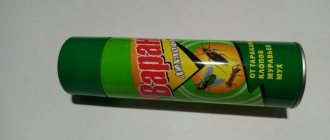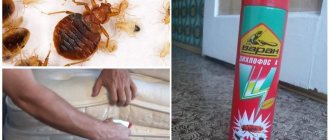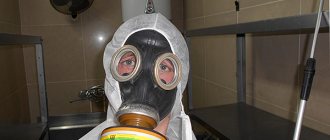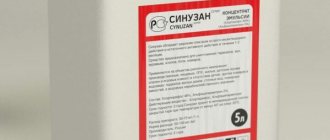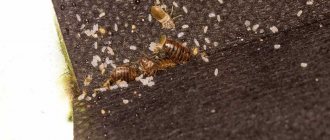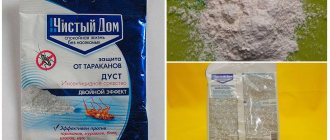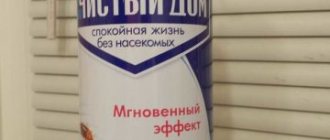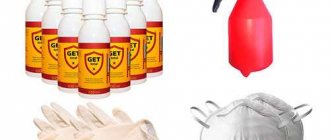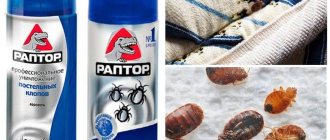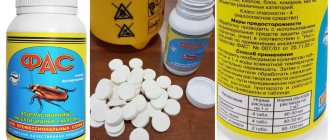To ensure the destruction of crawling and flying insects, as well as their nests, special means are used - insecticides. The insecticide most widely used in the former Soviet Union is dichlorvos. Modern aerosols distributed under this name are radically different from the Soviet formula.
What are the features of modern dichlorvos?
Previously, this drug was produced on the basis of dimethyl dichlorovinyl phosphate and was characterized by high toxicity and a strong pungent odor. But today, thanks to new technologies, the composition of the drug is very different from previous versions. The modern composition includes the main active ingredients: piperonyl butoxide, permethrin, cypermethrin, and in fact, only the name has survived to this day.
Each manufacturer claims that their product is the most harmless, has no odor and leaves no traces after treatment. The drugs are actually harmless and have a third class of danger. And if you use them in strict compliance with the instructions for use, they will not have any negative effects on either humans or animals.
Modern preparations really do not leave traces and can be used to treat sofas, walls, and mattresses.
But there is a smell. Of course, it is not as harsh as the drugs of the previous generation, but, nevertheless, many users have complaints about this from manufacturers.
Operating principle
The pyrethroids contained in dichlorvos disrupt the transmission of nerve impulses from the internal organs of the insect. Paralysis of the nervous system leads to rapid death. Active substances enter the body through the digestive and respiratory systems, as well as when the pest comes into contact with an insecticide-treated surface. Dichlorvos is capable of destroying individual individuals and entire colonies:
- cockroaches;
- flies;
- mosquitoes;
- os;
- hornets;
- ants;
- ticks;
- bedbugs;
- fleas;
- moths, etc.
Some believe that the absence of a pungent odor means the drug has low toxicity. This is wrong. Dichlorvos based on the pyrethroid group is still toxic to humans, especially harmful to sick people, the elderly, children, pregnant women, and pets.
Which dichlorvos to choose against bedbugs?
Currently, dichlorvos for bedbugs is being developed and produced by different manufacturers. The most famous brands are “Neo” and “Varan”, but there are others. They all have a common name - dichlorvos.
- Dichlorvos "Neo" is one of the most popular.
It has been familiar to consumers for a very long time. Available in cylinders. Quite economical. On the can of the substance there is an inscription stating that the product is odorless. Of course, there is a smell, but it is not pungent, with the addition of flavorings and it dissipates quite quickly. The drug is intended to destroy flying and crawling insects, about which there is also an inscription. To achieve good results in killing bedbugs, it is recommended to treat with this product twice. There should be a pause between treatments for one week and only after that it is possible to repeat all the activities again. If after repeated treatment traces of bedbugs are found, then subsequent treatment is recommended to be carried out no earlier than two weeks later. Dichlorvos "Neo" is a fairly common drug and is what can most often be seen on store shelves. The residual effect of the drug is short-lived, only two weeks, and this can be attributed to the disadvantages of this drug. - Dichlorvos "Varan". Like all drugs that are part of the dichlorvos group, this is a universal remedy, i.e. with its help you can fight not only bedbugs, but also cockroaches, flies, and ticks. The results of treatment with this product can be seen within two weeks or even more. It is during this period that the parasites will die and will not lose their ability to reproduce. The effectiveness of the drug is sufficient to destroy all small insects. But it depends on how quickly the room is ventilated after treatment. Therefore, it is advisable to ensure that fresh air does not enter the room for as long as possible. The main active ingredient that the aerosol contains is dimethyldichlorovinylphosphate. It has a paralyzing effect on nerve endings and leads to death in insects. The advantages of this drug are that it has a low price, is harmless to humans and animals, and is easy to use. These three important qualities motivate users to choose this product.
Of course, all of the above characteristics can be applied to other types of dichlorvos. But, judging by the reviews, “Varan” is still more effective.
How to use dichlorvos correctly?
It is necessary to remember that dichlorvos is a toxic substance, therefore, before starting treatment, you need to prepare for it and follow the sequence of actions:
- It is good to study the instructions for use.
- Prepare personal protective equipment - gloves, goggles, respirator. This is necessary to ensure that toxic substances do not enter the respiratory tract. Wear closed clothing.
- Before treatment, dust must be wiped off all surfaces so that the effectiveness of the product does not decrease.
- In order to provide access to corners and hidden areas, all furniture must be moved to the center of the room.
- Those things that cannot be treated with insecticide must be removed from the room.
- Sleeping materials are processed selectively - only the internal mechanism, legs, back of the mattress and seams.
- Keep windows and doors tightly closed during treatment and do not open them for several hours after treatment. This is done so that the insects are fully saturated with the toxic substance.
- The product is available in the form of an aerosol. Surfaces must be treated from a distance of no more than 20 cm. Only in this case can a uniform distribution of the substance be achieved. If the can is held high, the processing efficiency will deteriorate and the consumption of the substance will increase.
- After finishing the treatment, you must leave the room for at least 4 hours, closing the windows and doors.
- You can enter the room only after first ventilating the room.
- All surfaces need to be wiped with a damp cloth and then after cleaning and airing the unpleasant odor will disappear.
- It is recommended to carry out general cleaning after about a month.
Important! Do not spray dichlorvos on clothes! Clothes are processed in other ways.
You can achieve good results with:
- boiling;
- ironing;
- evaporation with a steam generator;
- washing at high temperatures;
- freezing.
These methods are quite effective and it is better to use one of them than to use an insecticide. A person will hardly be able to wear things treated with insecticide, because they will have an unpleasant odor.
Pros and cons of the product
Dichlorvos is chosen by a large number of consumers because it has a number of advantages. This is the ease of acquisition - you can order it online, buy it on the market, or in a household chemicals store. The drug is also fast-acting, and residual effects after treating a room with it can be seen for another 1 month.
There is a choice - to purchase Dichlorvos with or without a strong odor. It leaves no traces on the surface being treated, it simply evaporates. Universal - effective against many household pests, in addition to cockroaches. Can be used both in residential and industrial premises. The product consumption is 10 grams per square meter. It is low cost and available to every consumer.
The disadvantages of the insecticide are its increased toxicity to the human body - when carrying out treatment, be sure to use a protective mask or respirator, gloves and closed clothing. During the work, it is advised to remove animals, small children and other family members from their premises. It is recommended to seal aquariums or terrariums hermetically.
Do not spray Dichlorvos near indoor plants. Personal hygiene items, food, clothing, etc. should be removed or packed. Disinsection must be carried out with the ventilation turned off and the window open. If the drug does get into your eyes or nose, you should immediately rinse them with plenty of water.
What precautions should be taken during processing?
Despite the fact that dichlorvos is safe for humans, nevertheless, when working with it it is necessary to follow safety precautions:
- Use personal protective equipment.
- Avoid contact of the aerosol with the eyes, mucous membranes, wounds, ulcers, scratches.
- After finishing work, wash your face and hands with soap and rinse your mouth with clean water. If possible, take a shower.
- If large areas are being treated for a long time, then every 40 minutes it is recommended to take a 10-minute break, during which you need to breathe fresh air.
Reasons why dichlorvos is ineffective
In some cases, the use of dichlorvos is effective and helps to cope with parasites, but in other cases, on the contrary, the expected result does not occur. This depends on the following reasons:
- preparation for processing was carried out poorly;
- When inspecting the apartment, not all insect nests were discovered, since the female can lay eggs in different places and sometimes they can be located separately from the nest;
- no reprocessing was carried out;
- errors were made in the use of the aerosol - spraying was carried out from a long distance or the duration of spraying in each area was not maintained;
- General cleaning was carried out ahead of time.
Rules for successful pest control: preparation for attack and line of defense
We will conditionally divide all the rules into two categories: preparation for processing and the disinfestation process itself. So, before poisoning cockroaches, you must:
- Warn your neighbors about the impending war with the Prussians, or better yet, agree to carry out pest control measures for the entire entrance. Otherwise, your cockroaches will run to the neighbors, and then it’s just a stone’s throw away from spreading throughout the entire entrance, or even the house.
- Remove children and pets from the apartment. If you have fish, turn off the filter for a while and cover the aquarium with a tight lid to prevent chemicals from getting into the water. Remove children's toys and belongings, animal bowls and bedding.
- Remove towels, pillows, decorative rugs - in short, all textiles with which you come into direct contact and on which toxic substances can settle.
- Move furniture away from the walls (if possible).
- Open the windows to provide fresh air.
Read on the topic: Electronic cockroach repeller - a marketing ploy or salvation from the red scourge
Wear protective clothing that completely covers the entire body, as well as rubber gloves, a respirator, and safety glasses.
When all preparation steps have been completed, processing can begin.
There are the following rules for spraying aerosol insecticides:
- Shake the bottle well before spraying.
- Spray at arm's length from the face.
- Apply the product to corners, baseboards, window sills, the area near the trash can, under the refrigerator, behind kitchen cabinets, behind pictures, in all cracks and holes in the walls, in places where wallpaper has come off, on the legs and backs of furniture (especially those areas which are adjacent to the walls).
- After treatment, it is recommended to leave the apartment for two to three hours, leaving the windows open.
It is better to send children and pets to their grandmothers for a day.
If upon returning you feel normal, there is no dizziness or nausea, then the house is well ventilated. However, it would be a good idea to wet clean with a mild detergent to avoid tactile contact with the chemical.
Protect your eyes and skin from aerosols, do not neglect protective equipment, remember about ventilation, and then disinfestation measures will go like clockwork. Share this article with your friends so that they also know how to poison cockroaches using Dichlorvos, and subscribe to blog updates to be the first to read new articles. See you soon.
How to prevent bedbugs from appearing in an apartment?
After the treatment, you need to take measures to ensure that bedbugs no longer appear in the apartment. Here's what you need to do to do this:
- Check how well the ventilation ducts are closed. If the grille is damaged, it is best to install a fine mesh and treat the edges of the ventilation shaft with sealant. Bedbugs will not be able to crawl through small cells.
- Inspect water and gas pipes coming from neighbors, as well as telephone and Internet cables. It is recommended to seal all entrances with polyurethane foam.
- If the apartment has sockets of an old modification, which are directly connected to the neighboring ones, then it is better to dismantle them and cover up all the holes.
If dichlorvos did not help, what should I do?
If you cannot cope with a bedbug infestation on your own, you can seek the help of professionals. The favorite habitat of bedbugs is the bedroom, so the living rooms will be treated first. Experts find places where bedbugs live by following traces of their excrement - small black dots. The more black dots, the more infested. And next to them there may also be bedbug eggs, as well as their skins.
Companies provide a guarantee for bedbug treatment for 1-2 years. When concluding a contract, a mandatory condition is stipulated - the owner of the property must ensure complete sealing of the premises in order to prevent the arrival of bedbugs from neighbors.
If bedbugs appear again during the warranty period, exterminators carry out repeated treatment. The conditions for its implementation must be specified in the contract.
If bedbugs have not appeared in the apartment for a month, it is considered that the disinfection was successful and the apartment is completely cleared of insects.
Spider mites on indoor plants
Microscopic parasites are voracious organisms that affect over two hundred species of cultivated plants. The fight against spider mites on indoor plants is a constant problem for the gardener. The favorite delicacies of these creatures are citrus fruits, palm trees, ficuses, dracaena, balsam with fuchsia. The arachnid pest itself is extremely difficult to discern without instruments; adult specimens reach less than 1 mm in size.
Common types of spider mites:
- Common - omnivorous individuals of pale green or greenish-brown color, up to 0.6 mm in size, with darkish markings on the sides of their bodies.
- Atlantic - most often found on cucumbers.
- Red - heat-loving creatures, in the northern regions they hide in indoor areas.
- Turkestan - males are green, wintering females are reddish in color, loves melons, beans and cotton.
- Cyclamen - in addition to foliage, it damages tubers; when widespread, the plant becomes covered with a layer of dust.
- False is the smallest species; it forms a web at the final stage.
What do spider mites look like on indoor plants?
The damage caused by the microscopic organism is so obvious that it immediately forces the grower to look for a way to deal with the voracious alien. Although it is visually difficult to see spider mites on indoor plants, signs of their presence on the foliage are noticeable almost immediately:
- In places where leaf plates are bitten, white dots are visible on the underside at first, and darken over time.
- Affected foliage, deprived of quality nutrition, withers, curls and dies.
- Mass reproduction of the tick is accompanied in an advanced stage by the formation of a pale cobweb.
- If spider mites have spread in large numbers on indoor plants and the owner has not decided in time how to fight the parasite, then soon the depleted plants die.
Where do spider mites on houseplants come from?
Small arthropods have learned to hibernate, settling under plant debris, so most species of the parasite are found everywhere in the external environment. Once in rooms with a temperature of 25ºC-30ºC, the creatures reproduce all year round. A comfortable humidity level for an arachnid pest is 35% -55%. If spider mites have settled on indoor plants, decide how to deal with them immediately; the females of this parasite give birth to up to twenty generations.
Considering the reasons for the appearance of spider mites on indoor plants, scientists determined that all types of pests in enclosed spaces spread more strongly at low humidity. The exception is the false spider mite, but you have to fight this species less often. It is difficult to completely exclude pests from entering an apartment. There are many different ways for ticks to enter your home:
- with soil during transplantation;
- clinging to a garden tool;
- on clothes;
- with four-legged pets;
- with dirty shoes.
